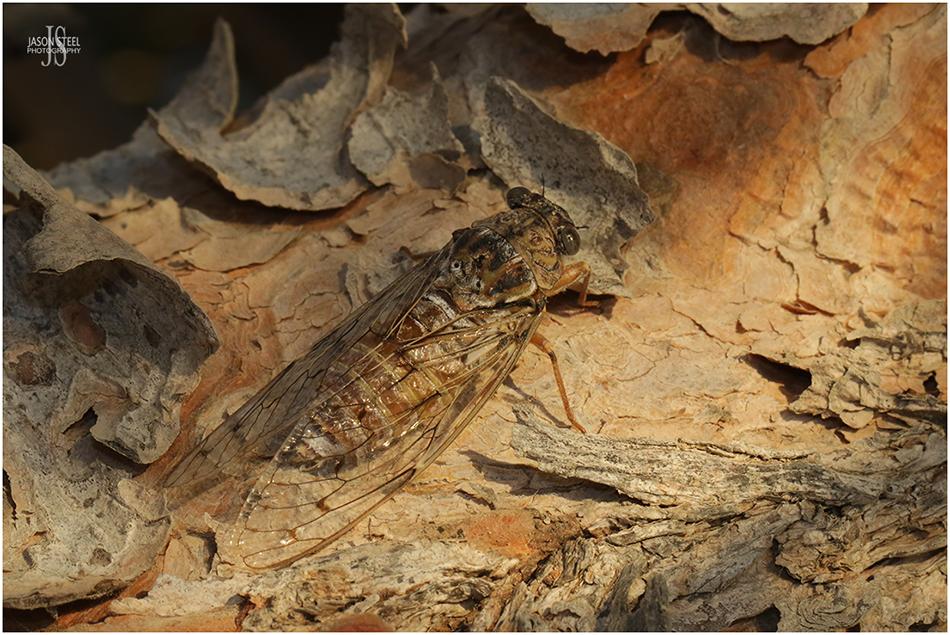
35mm Cicada on a tree in Cyprus. One of thousands heard calling as the day was drawing to a close. September 2023.
Cicadas
Cicadas are medium to large insects that grow from around 20-55mm in length. Cicadas are sometimes incorrectly referred to as locusts. Although they may resemble a cross between a cricket and a moth they're actually classified in the order Hemiptera, which includes other insects with piercing and sucking mouth-parts, such as Planthoppers, Aphids and Shieldbugs. Cicadas can be identified by their broad bodies and wide heads, clear membraned wings and large wide-set eyes. There are currently over 3000 different species of Cicada across the world and many can only be accurately distinguished by close inspection of their reproductive organs. Some can be identified by the characteristic call of the adult males. Many more new species are likely to be recognised in the future.
Cicadas generally can be divided into two categories, annual Cicadas and periodic Cicadas. Annual Cicadas usually live for between 2-5 years and can be seen as adults during their season every year. Periodic Cicadas can spend up to 17 years living as a nymph 1-2ft beneath the soil, feeding on sap from plant and tree roots. When the time is right periodic Cicadas emerge from the ground in mass. Occasionally this can result in plagues of Cicadas, that haven't been seen for 17 years, all emerging at the same time. None of the 13 year or 17 year periodic Cicada species occur in Cyprus. Adult Cicadas, both annual and periodic, typically only live for around 4-6 weeks. At least 4 Cicada species are common in Cyprus. These include: Black Sorrow Cicada (Cicadatra atra), Geminate Cicada (Lyristes gemellus), Ash Cicada (Cicada orni), and Melampsalta musiva.

One of many Cicadas on seen trees in Paphos, Cyprus, September 2023.
Cicadas are the loudest insects in the world. The song of the male Cicadas can exceed 100-120 decibels for some species. When large groups of males sing together the song can be heard from several miles away. The sound is produced by drum-like organs, called tymbals. that contract 300-400 times a second and resonate in the hollow abdomen of the Cicada in the same way that a hollow guitar chamber works. Male Cicadas have two separate songs that both sound the same to our ears. One song is for attracting a mate, whilst the other is used to send out a warning of a potential threat. Cicadas often sing in unison which makes it far more difficult for a predator, such as a bird, to locate an individual specimen. - LINK
Some Cicada species only sing at dusk. This would help avoid predation by birds. Most Cicada species, including those that I have photographed in Cyprus, could be heard singing throughout the day and early evening. Whilst male Cicadas produce their typical song the female Cicadas are limited to producing clicking sounds.
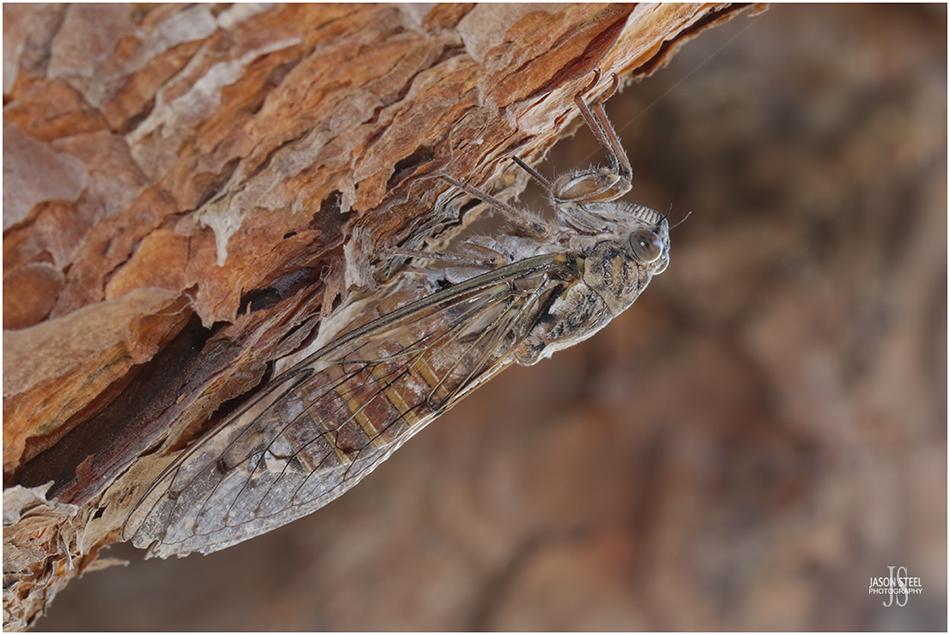
One of many Cicadas on seen trees in Paphos, Cyprus, September 2023.
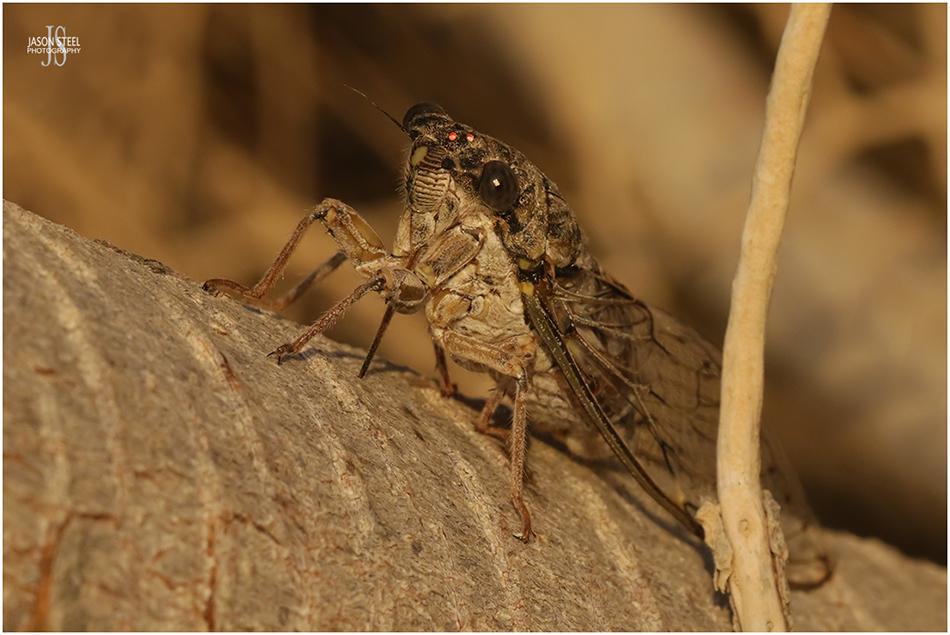
One of many Cicadas on seen trees in Paphos, Cyprus, September 2023.
The long piercing mouthparts of the Cicada are used for feeding on tree sap. Most Cicadas are considered to be generalist feeders and can feed on the tree sap from a variety of host trees, although many Cicada species do have preferred host plant and tree species. The young nymphs may even feed on the softer roots of grasses and other vegetation when very small. They then move on to feeding from the roots of the intended host tree.
The mouthparts of the Cicada consist of four needle-like tubes enclosed in a long, thin, beaklike sheath, known as the labium. Usually Cicadas do not bite humans. It is certainly possible for the labium to be used for self defence, if Cicadas are captured or handled, But defensive bites would be incredibly rare. Bites only usually occur if a Cicada has landed on a person's arm, or other part of the body, and remains at rest there for some time. It's possible the Cicada may mistake the human skin for the bark of a tree and insert its pointed labium into the skin, expecting to feed on tree sap. Whilst being stabbed by the labium would be painful Cicadas are harmless to humans and the chance of being bitten by one is incredibly rare.
Cicadas have five eyes. These consist of the two large compound eyes set at the corners of their head, as well as three simple eyes, positioned in a triangular pattern, in the centre of their forehead. These simple eyes, known as ocelli, often look red in photographs or when they catch the light at the right angle.
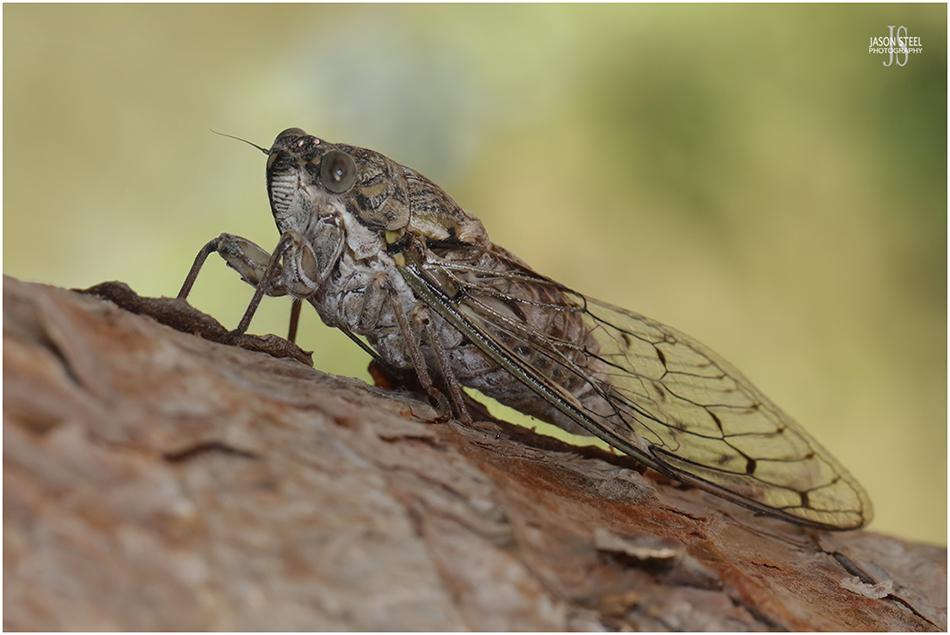
One of many Cicadas on seen trees in Paphos, Cyprus, September 2023.
After mating has taken place the adult female Cicada lays her eggs beneath, or in grooves, of the host tree bark. Once hatched the tiny nymphs drop to the ground and dig down into the soil. They will feed from the sap of tree and plant roots for 2-17y years before returning to life above the ground. Cicadas don't usually cause much harm to the host trees. Younger trees are more likely to suffer any damage. Periodic Cicadas emerge in greater numbers and are more likely to cause significant damage the host trees, simply due to their numbers, but most trees will make a full recovery once the adult Cicadas die off after 4-6 weeks.
In Illinois state, in the USA, both 13 and 17 year periodic Cicada species are native to the area. Once every 221 years the emergence of both these periodic species happens at exactly the same time in May and June. 2024 will be such a year. People are being advised to cover young and vulnerable trees with netting to prevent them sustaining damage from the Cicadas during this season. - LINK
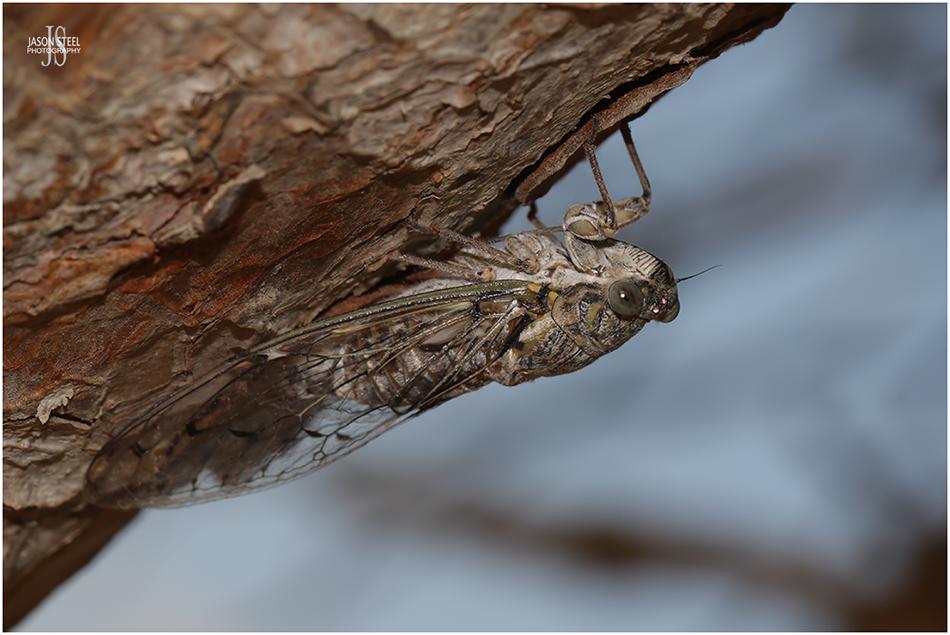
One of many Cicadas on seen trees in Paphos, Cyprus, September 2023.
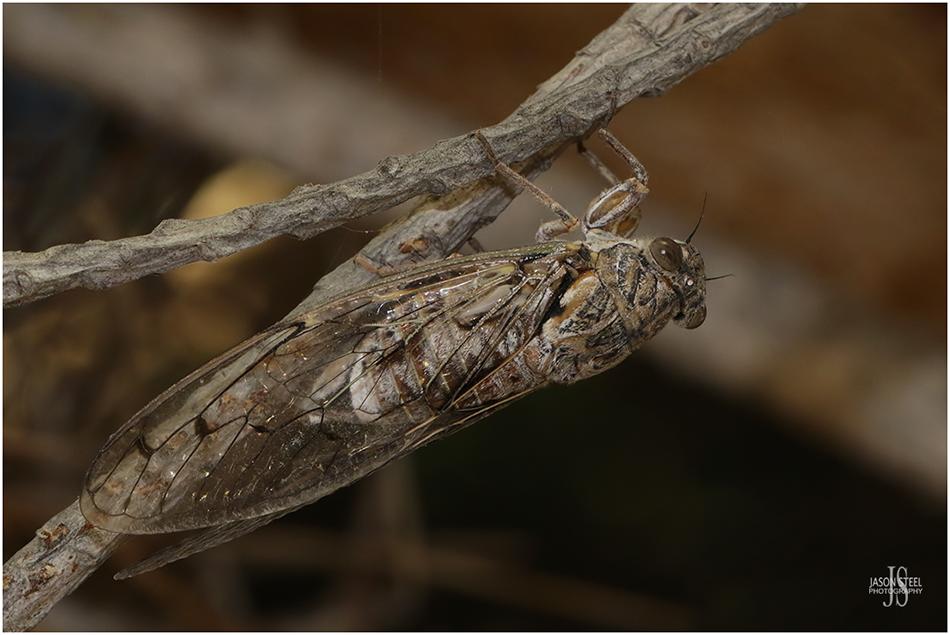
One of many Cicadas on seen trees in Paphos, Cyprus, September 2023.
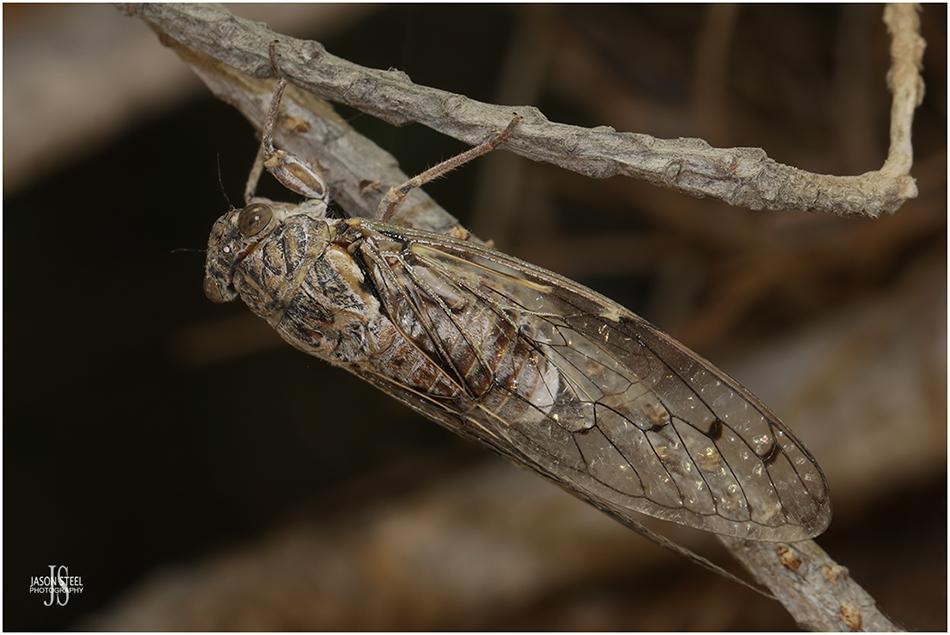
One of many Cicadas on seen trees in Paphos, Cyprus, September 2023.

One of many Cicadas on seen trees in Paphos, Cyprus, September 2023.
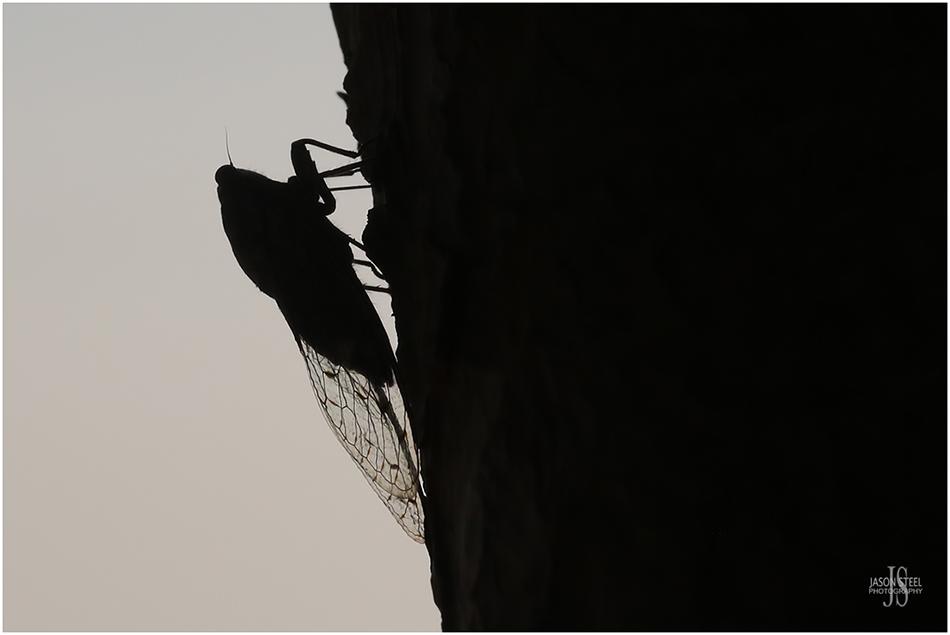
One of many Cicadas on seen trees in Paphos, Cyprus, September 2023.
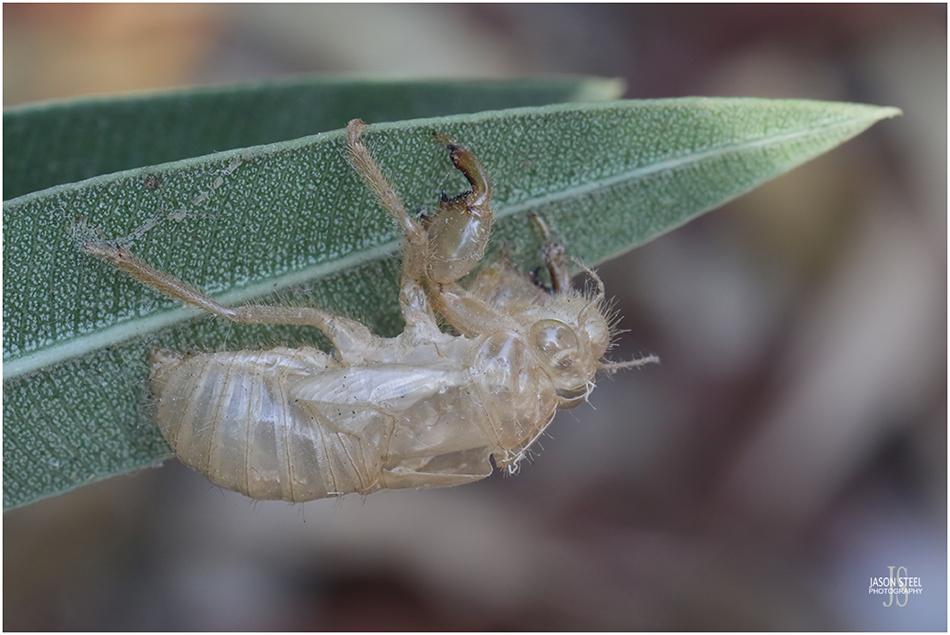
20-25mm Cicada exuvia found on low vegetation in Paphos, Cyprus, September 2023.
As you can see from this cast off exuvia the front legs of the Cicada nymph are specifically designed for digging. They allow the nymph to move around underground when looking for suitable plant and tree roots to feed from. They also allow the nymph to dig its way to the surface when it is ready to moult for the last time and emerge as a mature winged adult.

20-25mm Cicada exuvia found on low vegetation in Paphos, Cyprus, September 2023.
Cicadas in the UK
The UK has only one species of Cicada, the New Forest Cicada, Cicadetta montana. There is some dispute whether this species was first discovered in 1812 or 1819. This large Cicada grows to a length of around 30+mm. Cicadetta montana emerge from late May until early July and live for just 2-4 weeks as an adult. Unlike many other species of Cicada the New Forest Cicada's song isn't audible to everyone. The song of the male is at such a high frequency that it's outside the hearing range of many humans and is only usually audible to the young. The call of Cicadetta montana is reported to like static hiss, to the unaided human ear, and the long sustained call includes relatively short lulls at irregular intervals. It is believed these Cicadas take 6-10 years to develop beneath the soil, and possibly as long as 17 years. The New Forest Cicada could previously only be heard singing on warm, sunny days, when there was little or no wind, in sunny, south-facing clearings in the forest.
Unfortunately the New Forest Cicada is now extremely rare, or lost completely, in the UK. In fact there hasn't been a confirmed sighting anywhere in Britain since 1993, over 30 years ago. This species has long been considered as critically endangered in the UK and for some time it has been feared that the New Forest Cicada may already be extinct in the Britain. As such this species is protected under Section 5 of the Wildlife and Countryside Act 1981, making it an offence to harm or capture specimens. There was an unconfirmed report of Cicadas singing in the year 2000. - LINK
In 2013 a smartphone app had become available to help detect sound beyond the normal human hearing range. At the time this app was being used by a growing number of people who were actively searching the New Forest in the hope of once again discovering the missing Cicadetta montana. By 2015 over 3000 users had downloaded the app and yet none of these people had any success detecting the call of the New Forest Cicada. In 2016 100 autonomous acoustic monitoring devices were deployed each year throughout the New Forest but none of these devices were able to detect the presence of the New Forest Cicada. Despite its long absence there was still hope even in 2021 that this elusive Cicada would eventually be rediscovered in the UK as this wasn't the first time the New Forest Cicada had disappeared for a long period of time. The New Forest cicada was also previously missing in the UK between the years 1941 and 1961. In 1962, after a 20 year absence, Cicadetta montana re-emerged once again from beneath the soil in the New Forest. As such it was hoped that their current long absence might just be part of the Cicadas' unusual life cycle, with the possibility that countless nymphs could still be lying somewhere beneath the soil waiting to emerge.
In September 2023 Natural England listed the New Forest Cicada as extinct in the UK and a grant was approved from the Government's Species Recovery Programme Grant Scheme, to the Species Recovery Trust, to launch a reintroduction program for Cicadetta montana to be brought back to the New Forest. Aaron Harper, of Planet Radio, wrote an article on the allocation of these funds from Natural England to help with rare invertebrates in this country. The article mentioned the planned source of the specimens that will begin the reintroduction of this species to the New Forest: "Another project included the reintroduction of the New Forest Cicada, led by the Species Recovery Trust, which will be brought from Slovenia to a zoo in England, to be bred in captivity, before released back into the New Forest."
Outside of the UK Cicadetta montana is found throughout Europe, and parts of Asia. In many Western European countries Cicadetta montana is considered to be endangered, or has already vanished completely.
- - - - - - - - - - - - - - - - - - - - - - - - - - - - - - - - - - - - - - - - - - - - - - - - - -
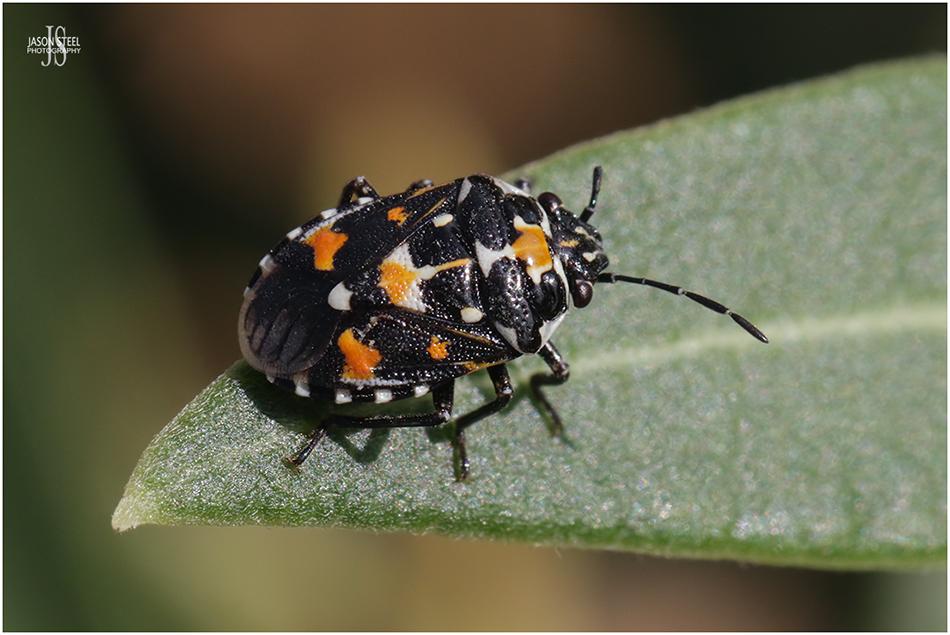

Variegated Caper Bugs found on ornamental flowers in Paphos, Cyprus, September 2023.
Variegated Caper Bug - (Stenozygum coloratum)
The Variegated Caper Bug is a small Shieldbug / Stink Bug from the Stenozygum genus, which consists of several similar species. The base colour is black but this colourful bug has bold orange and white markings. Adult females can grow up to a length of 7mm. The slightly smaller males reach up to 6mm in length. This Shieldbug feeds primarily on Brassicaceae and Capparaceae plants, but is narrowly polyphagous, and may also feed on other plants if necessary. This species is typically active from May until the end of October, before commencing a winter diapause. The peak season being August and September. The barrel-shaped eggs are typically laid on the leaves of the host plant, and measure around 1mm in length. They are an off-white colour with a brown band around the top end. These eggs are usually laid in batches of around 12 eggs. Sometimes individual specimens can gather to form large aggregations. In large groups these bugs can cause the early withering of their host plants.
It was recently discovered that the eggs of the Variegated Caper Bug are used as an alternative host for the Chalcid Wasp, Ooencyrtus pityocampae. Ooencyrtus pityocampae is an egg parasitoid that primarily targets the Pine Processionary Moth, Thaumetopoea wilkinsoni, a major pest of Pine trees. Ooencyrtus pityocampae is known to flourish in areas with a dense population of the Variegated Caper Bug, and as such the presence of the Variegated Caper Bug maybe a necessary biological control to restrict the spreading of the Pine Processionary Moth in areas where it could become a problem.
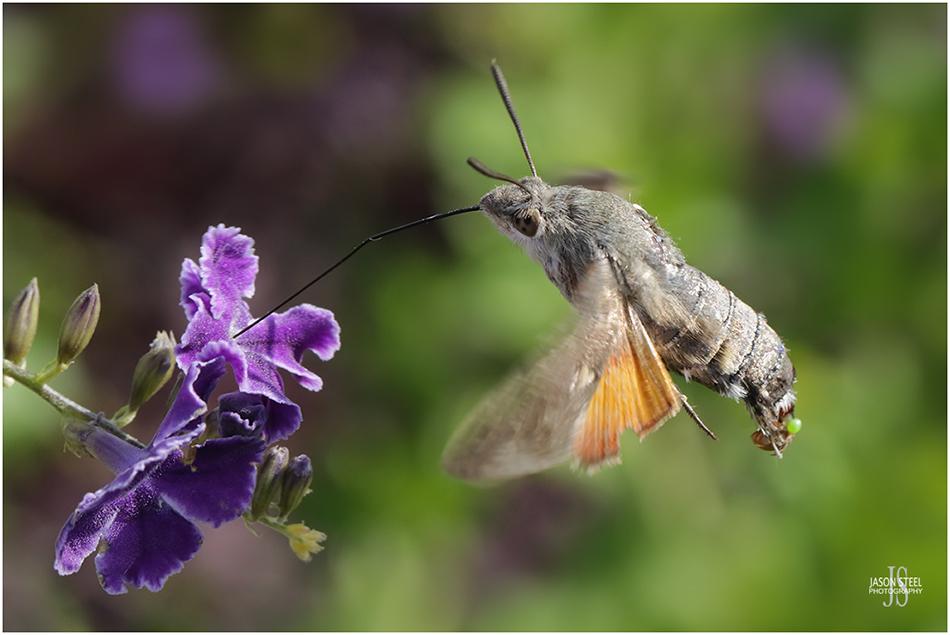
A rather battered end-of-season Humming-bird Hawk Moth, Paphos, September 2023.
Hummingbird Hawk-Moth - (Macroglossum stellatarum)
The Hummingbird Hawk-Moth is widespread across much of Europe, UK, North Africa and parts of Asia. It has a broad, dull greyish-brown abdomen with black and white chequered rear end, that has a fan of bristle-like hairs. The forewings are the same colour as the abdomen, but have black wavy lines across them. The hindwings are orange with a black edge. The typical wing-span is around 40-50mm, sometimes up to 58mm. It's easy to see where the Hummingbird Hawk-Moth gets its name from when you see one feeding in flight. Rather than land on the flower to feed on the nectar the Hummingbird Hawk-Moth hovers above the trumpet shaped flowers and feeds whilst in flight with its long proboscis, which itself can measure up to 28mm in length. The Hummingbird Hawk-Moth can be found in gardens, parks, meadows and woodland edges. Adults overwinter in gaps or cracks in rocks, trees and even buildings. It's not unusual for these hibernating moths to emerge to feed on mild winter days. This is a migrant species and many adult specimens seen in the UK will have flown over from Europe or Africa, but this moth also breeds in the UK too.
The larvae, when first hatched, are a clear yellow colour. By their second instar they take on a green colouration. The preferred food plants are Bedstraws (Galium) or Madders (Rubia) but the larvae have also been recorded on other Rubiaceae and Centranthus, Stellaria, and Epilobium. In the UK the larvae can be found from June to October, with August being the peak month. In southern Europe the Hummingbird Hawk-Moth can have up to three broods in one year.
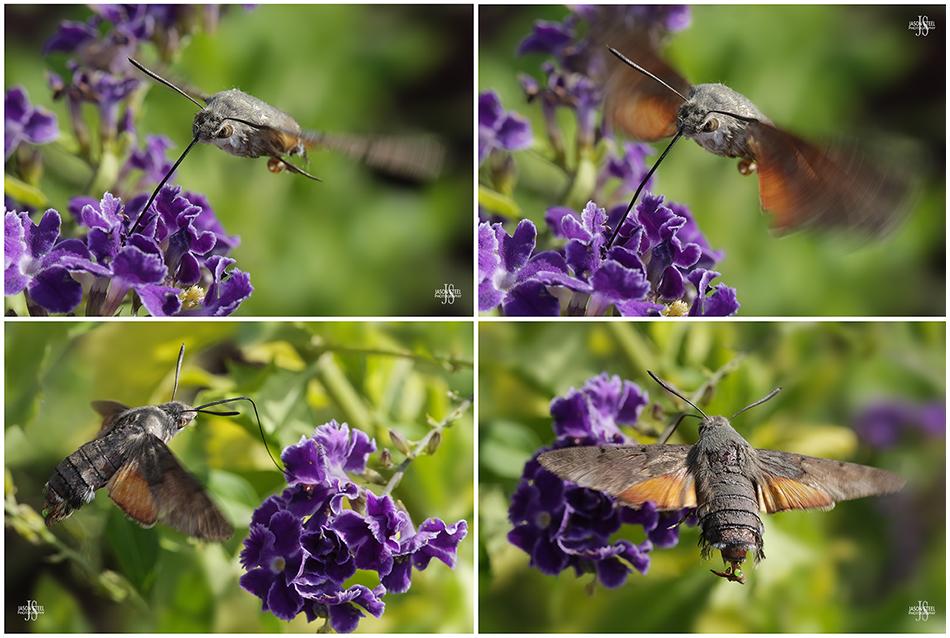
A rather battered, end-of-season Humming-bird Hawk Moth, Paphos, September 2023.